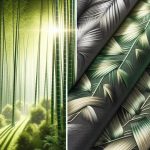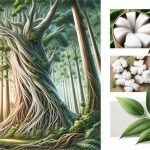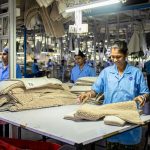When you compare the water consumption of Tencel™/Lyocell to cotton, when you consider production methods, and when you evaluate sustainability, the differences become striking. Tencel’s closed-loop system recycles water and solvents, markedly reducing its environmental impact. But how does this innovative approach stack up against cotton’s resource demands? The answer reveals vital insights into the future of sustainable textiles.
Table of Contents
Key Takeaways
- Tencel production requires significantly less water than cotton, addressing water scarcity issues in textile manufacturing.
- The closed-loop system in Tencel production recycles water, minimizing waste and conserving resources effectively.
- Almost 99% of solvents used in Tencel production are recovered, reducing environmental impact compared to traditional textiles.
- Eucalyptus trees for Tencel are sourced from sustainable forestry practices, promoting ecological responsibility and resource preservation.
- Choosing Tencel supports a more sustainable textile industry, contributing to lower water footprints and eco-friendly production practices.
Water Usage Comparison: Tencel vs. Cotton
When comparing the water usage of Tencel™ (Lyocell) and cotton, you’ll find that Tencel remarkably outperforms cotton in sustainability.
Tencel requires considerably less water during its production process, making it a smarter choice if you’re conscious about your environmental impact. While cotton cultivation demands vast amounts of water, often leading to water scarcity in farming regions, Tencel utilizes sustainable wood sources that thrive in rainforests. This means less strain on water resources.
Additionally, Tencel’s production process minimizes wastewater, ensuring that the water used is recycled effectively. By choosing Tencel, you contribute to a more sustainable textile industry, reducing your water footprint and promoting responsible consumption.
It’s a win-win for both you and the planet!
The Closed-Loop Production System
In the closed-loop production system of Tencel™, you’ll see a remarkable water reuse mechanism at work.
This process not only recovers solvents effectively but also greatly reduces the overall environmental impact.
Let’s explore how these innovations contribute to a more sustainable textile industry.
Water Reuse Mechanism
The closed-loop production system utilized in the creation of Tencel™/Lyocell fibers greatly enhances water reuse, making it a sustainable choice for textile manufacturing.
In this process, water used during fiber production is collected, treated, and recycled back into the system. This efficient mechanism minimizes waste and considerably reduces the overall water footprint.
You’ll find that the closed-loop design guarantees that water is constantly reused, rather than being discarded after a single use.
By prioritizing water conservation, Tencel™/Lyocell not only lowers its environmental impact but also sets a standard for sustainable practices in the industry.
When you choose Tencel™/Lyocell, you’re supporting a brand that values resource preservation through innovative water reuse methods.
Solvent Recovery Process
While many textiles rely on harmful chemicals, Tencel™/Lyocell employs a solvent recovery process that exemplifies its commitment to sustainability.
This closed-loop production system guarantees that solvents used in the fiber-making process are recycled and reused, greatly reducing waste and environmental impact.
Here’s what makes this process stand out:
- Minimal Waste: Almost 99% of the solvent is recovered and reused.
- Eco-Friendly Solvents: The solvents used are non-toxic and biodegradable.
- Reduced Resource Consumption: It lowers the need for fresh resources, conserving water and energy.
- Efficient Production: The closed-loop system enhances efficiency, making the process sustainable and cost-effective.
Environmental Impact Reduction
Tencel™/Lyocell’s closed-loop production system not only recycles solvents but also greatly minimizes environmental impact. In this system, around 99% of the solvents used in fiber production are captured and reused, considerably reducing waste.
This efficient process means fewer harmful chemicals enter the ecosystem, making Tencel™/Lyocell a more sustainable choice compared to traditional textiles. You’ll notice that the water usage is also lower, as the process requires less water than cotton production.
Plus, the cultivation of raw materials, like eucalyptus trees, benefits from sustainable forestry practices. By choosing Tencel™/Lyocell, you’re supporting a textile that prioritizes environmental responsibility and promotes a healthier planet for future generations.
It’s a win-win for you and the environment!
Benefits of Water Conservation in Textile Production
When you focus on water conservation in textile production, you enhance resource management and promote sustainable practices.
This not only reduces waste but also guarantees that you’re contributing to a healthier environment.
Enhanced Resource Management
As the demand for sustainable textiles grows, effective water conservation in textile production becomes increasingly essential.
By adopting enhanced resource management practices, you can markedly reduce water usage and minimize environmental impact.
Here are some benefits of focusing on water conservation:
- Lower operational costs: Reducing water consumption can save money on utility bills.
- Improved brand reputation: Consumers are more likely to support brands committed to sustainability.
- Regulatory compliance: Staying ahead of regulations helps avoid penalties and fosters long-term viability.
- Resource efficiency: Utilizing water more wisely allows for better overall management of resources.
Prioritizing water conservation not only benefits the environment but also enhances your textile production’s efficiency and sustainability.
It’s a win-win for everyone involved!
Sustainable Production Practices
Adopting sustainable production practices is key to maximizing the benefits of water conservation in textile manufacturing. By implementing efficient water management strategies, you can markedly reduce water usage and enhance the ecological footprint of your operations.
Techniques like closed-loop systems help recycle water, minimizing waste and pollution. Choosing renewable fibers, like Tencel™/Lyocell, also supports sustainability, as these materials require less water compared to traditional cotton.
Additionally, fostering partnerships with suppliers committed to responsible practices can amplify your efforts, creating a more sustainable supply chain.
Ultimately, by prioritizing water conservation, you not only protect valuable resources but also improve your brand’s reputation and appeal to environmentally conscious consumers. Embracing these practices creates a win-win for both business and the planet.
Chemical Use and Environmental Impact
While Tencel™/Lyocell is often praised for its eco-friendly production process, it’s essential to contemplate the chemicals used and their environmental impact.
Even though the solvent used in Tencel™ production is non-toxic and recycled, you should still be aware of a few concerns:
- Chemical exposure: Workers can be at risk during the production process if proper safety measures aren’t in place.
- Water pollution: If wastewater isn’t treated effectively, harmful substances can affect local ecosystems.
- Resource consumption: Though the process is less water-intensive than cotton, energy and resources are still used.
- Sustainability of wood sources: The origin of raw materials can impact biodiversity and forest health.
Comparing Tencel to Other Sustainable Fabrics
Tencel™/Lyocell stands out in the domain of sustainable fabrics, but it’s worth comparing it to other eco-friendly options to understand its unique advantages.
For instance, organic cotton is a popular choice, yet it requires more water for cultivation than Tencel. Bamboo fabric, often touted for its sustainability, can involve harsh chemical processes that diminish its eco-friendliness.
Hemp is another contender, known for its low water usage and fast growth, but it’s less versatile regarding softness and drape compared to Tencel.
Ultimately, while each fabric has its merits, Tencel strikes a balance between environmental impact and luxurious feel, making it a compelling choice for those who prioritize sustainability without sacrificing comfort.
Durability and Performance of Tencel
Experience the remarkable durability and performance of Tencel™/Lyocell, which has quickly become a favorite among consumers seeking long-lasting fabrics.
You’ll appreciate how Tencel withstands daily wear while maintaining its luxurious feel.
Here are a few standout features:
- Moisture-wicking: Keeps you dry by absorbing moisture effectively.
- Breathable: Promotes airflow, making it comfortable for all-day wear.
- Softness: Feels gentle against your skin, perfect for sensitive individuals.
- Resistant to wrinkles: Stays looking fresh with minimal effort on your part.
With Tencel, you’re not just investing in a fabric; you’re choosing a reliable option that combines comfort and longevity, ensuring you enjoy your garments for years to come.
Reducing Environmental Impact With Tencel
As consumers become more eco-conscious, choosing sustainable fabrics like Tencel can remarkably reduce your environmental footprint.
Tencel, made from sustainably sourced wood pulp, uses a closed-loop production process that recycles water and solvents, minimizing waste. By opting for Tencel over conventional fabrics, you support a more sustainable textile industry.
The production of Tencel requires considerably less water compared to cotton, conserving precious resources. Additionally, Tencel’s biodegradability means it won’t linger in landfills like synthetic fibers.
When you wear Tencel, you’re not just choosing comfort and style; you’re making a positive impact on the planet. Every small choice you make contributes to a larger movement towards sustainable living, helping to preserve our environment for future generations.
The Future of Sustainable Textiles and Tencel’s Role
While the textile industry faces increasing pressure to adopt sustainable practices, Tencel plays a pivotal role in shaping the future of eco-friendly fabrics.
As you explore sustainable textiles, you’ll discover how Tencel stands out for its innovative approach. It’s not just about reducing water footprints; it’s about creating a circular economy.
Consider these key aspects of Tencel’s impact:
- Biodegradable: Tencel fibers break down naturally, minimizing landfill waste.
- Closed-loop process: The production uses solvents that are recycled, reducing chemical pollution.
- Renewable resources: Derived from sustainably sourced wood, Tencel promotes responsible forestry.
- Softness and durability: Tencel textiles combine comfort with longevity, making them a smart choice.
Frequently Asked Questions
How Is Tencel Produced From Wood Pulp?
About 99% of the solvents used in Tencel production are recycled. To make Tencel, you’d dissolve wood pulp in a solvent, spin it into fibers, and then dry, creating a sustainable fabric for your wardrobe.
What Are the Environmental Benefits of Using Tencel?
Using Tencel offers several environmental benefits. It’s biodegradable, requires less water during production, and comes from sustainably sourced trees. You’re making a positive impact by choosing Tencel over more resource-intensive fabrics like cotton.
Is Tencel Biodegradable or Compostable?
Isn’t it great to know that Tencel™ is both biodegradable and compostable? When you choose Tencel™, you’re opting for a sustainable material that breaks down naturally, reducing waste and benefiting the environment in the long run.
How Does Tencel Impact Textile Recycling Efforts?
Tencel enhances textile recycling efforts due to its cellulose-based composition, which allows for easier breakdown and repurposing. By choosing Tencel, you contribute to a more sustainable fashion industry and support closed-loop recycling processes.
What Certifications Does Tencel Hold for Sustainability?
Tencel’s sustainability certifications include the Global Organic Textile Standard (GOTS) and the OEKO-TEX® Standard 100. These guarantee you’re purchasing textiles made from responsibly sourced materials, promoting environmentally friendly practices in the textile industry.
- The Use of Nonwovens in Construction and Civil Engineering - July 11, 2025
- The Use of Nonwovens in Construction and Civil Engineering - July 11, 2025
- The Use of Nonwovens in Construction and Civil Engineering - July 11, 2025







